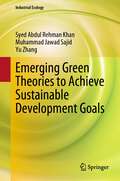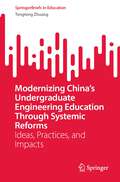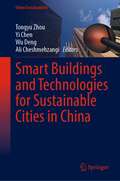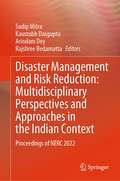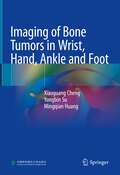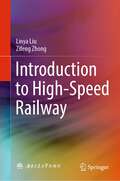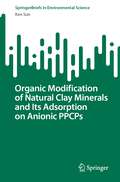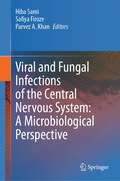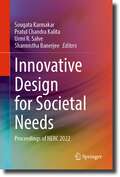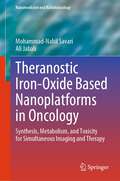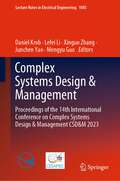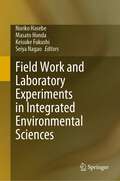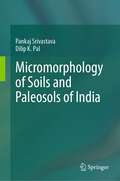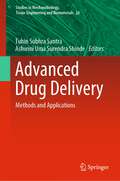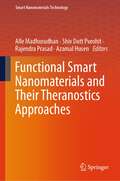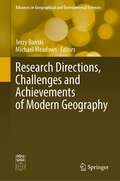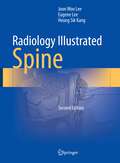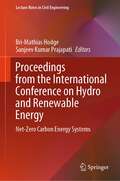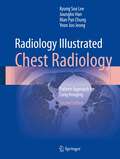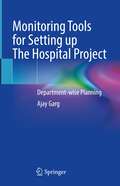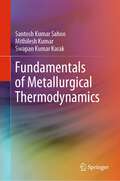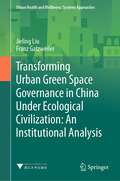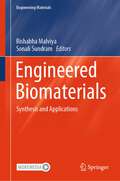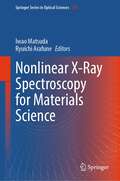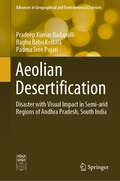- Table View
- List View
Emerging Green Theories to Achieve Sustainable Development Goals (Industrial Ecology)
by Muhammad Jawad Sajid Yu Zhang Syed Abdul KhanThis book opens up a critical dimension to the field of industrial ecology. The book discusses the emerging green theories in industrial ecology and evolving practices adopted by businesses to achieve Sustainable Development Goals. The author(s) identifies valuable lessons to be learned and presents conceptual frameworks and ideas to guide future industrial ecology applications, which are integrated into the triple bottom line approach and have cornerstone value to achieving Sustainable Development Goals. Additionally, the book discusses the relevant economic theories that serve as the foundation for the presented green views. This elaboration of economic ideas reinforces our work's relevance to achieving a green economy. Therefore, this book is essential for industrial ecology scholars and those interested in ensuring an environmentally sustainable future.
Modernizing China’s Undergraduate Engineering Education Through Systemic Reforms: Ideas, Practices, and Impacts (SpringerBriefs in Education)
by Tengteng ZhuangThis book examines the comprehensive engineering education reform since China put forward its New Engineering Education policy in early 2017. It presents systematic reform measures at micro-level, such as national policies on massively building up new programs that cater to emerging state-of-the-art technologies in the industry, on developing synergistic approaches to education through tightened university–industry collaboration, and on formulating the four-level quality assurance mechanisms. The book also addresses meso-level institutional schemes and implementations at several case universities researched, and micro-level issues directly regarding teaching and student learning based on empirical studies.Overall, this book provides the international community the knowledge of how international benchmarking of university engineering education is reflected in the Chinese context, and helps readers to gain an understanding the success and failure of different practices in achieving relevant reform goals.
Smart Buildings and Technologies for Sustainable Cities in China (Urban Sustainability)
by Tongyu Zhou Yi Chen Wu Deng Ali CheshmehzangiThis book brings together the insights from professional associations who involved in developing relevant national standards in China, domestic and international scholars who are dedicated to research in related fields, and industry practitioners who have the most hands-on experience. Synthesizing their perspectives, this book discusses the advanced technologies that can meet the requirements for energy efficiency, building performance monitoring and management, and user-centric building services, which are considered the essential components for achieving sustainable and smart cities. Moreover, it provides reflections on the implementation of smart technologies and strategies in practice.
Disaster Management and Risk Reduction: Proceedings of NERC 2022
by Sudip Mitra Kaustubh Dasgupta Arindam Dey Rajshree BedamattaThis book presents select proceedings of North-East Research Conclave (NERC 2022) that will help pave way toward disaster risk reduction through a holistic and multidisciplinary approach. The book discusses topics, such as rapid pace of climate change, its deleterious effects on nature and natural systems, human interventions in altering the natural geographical and geological systems, widespread urbanization, recurrent unwarranted rainfall and cloud bursts, unprecedented flooding, catastrophic landslides, dam breakages, glacial outbursts, snow avalanches, seismicity and its impacts, liquefaction, and wreaking environmental pollution leading to unimaginable toll on lives, property and economy. The book also discusses approaches to address such issues and frame a refined path towards a sustainable future, such as a three-fold approach like – Awareness, Inferences and Implementations. For this approach, it is ardently necessary to understand the core reasoning behind the disasters, their impact on the socio-economic contexts, and the ways to mitigate them. The book can be a valuable reference for beginners, researchers, and professionals interested in disaster risk reduction and allied fields.
Imaging of Bone Tumors in Wrist, Hand, Ankle and Foot
by Xiaoguang Cheng Yongbin Su Mingqian HuangThis book provides a detailed description of typical imaging features of bone tumors and tumor-like lesions in the wrist, hand, ankle and foot. Each chapter deals with one major bone tumor or tumor-like lesions, for example, chondroma, enchondroma, gout, giant cell tumors, lymphoma, osteosarcoma, bone metastases, etc. Typical cases are carefully selected from thousands of clinical cases accompanying with comprehensive imaging information of X-ray, CT and MRI. In-depth analysis and differential diagnostic tips from experienced bone tumour specialists is presented at the end of each chapter. This book will be useful and worthy to musculoskeletal radiologists, orthopaedic surgeons, general radiologists, and oncologists.
Introduction to High-Speed Railway
by Linya Liu Zifeng ZhongThis book provides a comprehensive overview of various aspects of high-speed railways, such as infrastructure, communication signals, traction power supply, trainsets, and transportation organization. It delves into the basic concepts, fundamental theories, and the latest technological achievements in these areas, equipping readers with a strong foundation in the subject matter. The content is organized into eight chapters: Introduction, High-Speed Railway Lines and Infrastructure, Power Supply Systems, High-Speed Railway Trainsets, Signal and Communication Systems, Transportation Organization, Passenger Services, and Maglev Railways. Each chapter explores different facets of high-speed railway systems, focusing on the unique characteristics, design principles, and operational methodologies that set them apart from traditional railway systems. The book also highlights recent breakthroughs and innovations in the field, giving readers a glimpse of the future potential of high-speed railways. The book is tailored to meet the needs of undergraduate and graduate students pursuing degrees in railway transportation, railway engineering, locomotive vehicles, electrical traction, signal communication, and related fields. It offers a systematic and in-depth understanding of high-speed railway systems, enabling students to grasp the subject matter and apply their knowledge to real-world situations. It can also be a training material for railway professionals looking to expand their knowledge and skills in high-speed railway systems. Furthermore, the book can be a useful reference for postgraduate students engaged in research in relevant fields. It offers a wealth of information and insights, assisting researchers in understanding the intricacies of high-speed railway systems, and exploring new avenues for innovation and improvement.
Organic Modification of Natural Clay Minerals and Its Adsorption on Anionic PPCPs (SpringerBriefs in Environmental Science)
by Ken SunThis book mainly investigates the adsorption of anionic diclofenac sodium on natural clay minerals, the adsorption of anionic chloramphenicol on natural clay minerals and the behavior of surface and interface modification or adsorption on clay minerals. It has significant guidance for learning the transfer and fate of pharmaceuticals and personal care products (PPCPs) in the soil. It develops an efficient, low-cost adsorbent material and provides theoretical basis and valuable reference for the effective prevention of groundwater contamination of PPCPs in the field of environmental engineering.
Viral and Fungal Infections of the Central Nervous System: A Microbiological Perspective
by Hiba Sami Safiya Firoze Parvez A. KhanThis book covers topics related to viral and fungal infections of the central nervous system (CNS), with a multidisciplinary reach, discussing associated immunology, microbiological aspects, pathologies, timely management, and prevention. The book is structured into five broad sections. The first section provides the reader with valuable insights into the aetiologies and underlying pathophysiological mechanisms of neurological diseases, including host responses. It mentions all bacterial, fungal, parasitic, and viral causes of neuro-infections, along with rarer neuropathogenesis such as prions and mycoplasmas. The chapter also presents detailed epidemiology and prevalence of different CNS infections worldwide. It also reviews various infectious diseases that target the nervous system, such as focal lesions, meningitis, and neurological complications of venous sinus thrombosis. The next two sections delve deep into pathogen-specific diseases of the CNS, namely the viruses and fungi associated with neuro-infections. It mentions detailed excerpts on encephalitic viruses, long-term consequences of neurotropic viruses, mycological neuroinfectious, and even the emerging, less talked of viruses and fungi causing neurological disease. Topics such as principles of vigorous antifungal therapy and surgeries are also discussed in the chapter. The fourth section gives an insight on prospects for efficiently diagnosing and managing viral and fungal CNS infections, to tackle associated morbidities. Features that are often less documented, yet of considerable interest in current times, such as the role of immunosuppression in neurological infections and newer microbiological diagnostic strategies are covered. The last section uniquely provides clinicians with relatable case scenarios. Real case descriptions are included, such as cases of fungal meningitis and other difficult-to-diagnose infections produced by viruses. This book serves as a guide for neurologists, medical microbiologists, and clinical practitioners who deal with patients suspected of neurological infection.
Innovative Design for Societal Needs: Proceedings of NERC 2022
by Sougata Karmakar Pratul Chandra Kalita Urmi R. Salve Sharmistha BanerjeeThis book presents select proceedings of North-East Research Conclave (NERC 2022) on innovative design for societal needs. Human Society and culture are a continuously evolving, complex, and intelligent system. The social needs of humans today are exacerbated by extremely unbalanced regional economic development and cultural identity crises across the globe and within states. This edited book presents cutting-edge research on how design innovation can be used to bring sustainable and meaningful social change. It also provides novel directions for future researchers interested in exploring the impact of design innovation and design thinking on human society. The book can be a valuable reference for beginners, researchers, and professionals interested in innovative design and allied fields.
Theranostic Iron-Oxide Based Nanoplatforms in Oncology: Synthesis, Metabolism, and Toxicity for Simultaneous Imaging and Therapy (Nanomedicine and Nanotoxicology)
by Mohammad-Nabil Savari Ali JabaliThis book highlights the most efficient and latest ways to deal with cancer, focusing on IONPs. The book describes some well-designed surface modifications performed through several functional materials over the surface of IONPs, which results in the development of multifunctional IONPs-based delivery nanoplatforms by enhancing solubility, stability, and avoiding side effects on healthy cells. Several types of stimuli-responsive IONPs-based strategies are also discussed. Owing to magnetic, structural, and thermal properties, IONPs themselves can be utilized for magnetic targeting, magnetic hyperthermia, and phototherapy. Significant advancements are presented in IONPs-based immunotherapy, radiotherapy, and sonodynamic therapy for the efficient treatment of cancer. Finally, the book presents RIONs which serve as the parent platform for the development of powerful DMCAs utilized in SPECT/MRI and PET/MRI applications.
Complex Systems Design & Management: Proceedings of the 14th International Conference on Complex Systems Design & Management CSD&M 2023 (Lecture Notes in Electrical Engineering #1085)
by Daniel Krob Lefei Li Xinguo Zhang Junchen Yao Mengyu GuoThis book contains all refereed papers accepted during the 14th International Conference on Complex Systems Design & Management CSD&M 2023 that took place in Beijing, People’s Republic of China by the end October 2023. Mastering complex systems requires an integrated understanding of industrial practices as well as sophisticated theoretical techniques and tools. This explains the creation of an annual go-between European and Asian forum dedicated to academic researchers and industrial actors working on complex industrial systems architecting, modeling and engineering. These proceedings cover the most recent trends in the emerging field of complex systems, both from an academic and professional perspective. A special focus was put this year on “New Trends in Complex Systems Engineering.” The CSD&M series of conferences were initiated under the guidance of CESAM Community in Europe, managed by CESAMES. Its Asian version took place in Singapore for three consecutive sessions during 2014 and 2018. The fourth Asian edition was held in Beijing in hybrid with the Chinese Society of Aeronautics and Astronautics (CSAA) as the co-organizer in 2021. Since 2023, its European and Asian conferences merge into one, taking place in China and Europe in turn. CESAM Community aims in organizing the sharing of good practices in systems architecting and model-based systems engineering (MBSE) and certifying the level of knowledge and proficiency in this field through the CESAM certification. The CESAM systems architecting, and model-based systems engineering (MBSE) certification is especially currently the most disseminated professional certification in the world in this domain through more than 3,000 real complex system development projects on which it was operationally deployed and around 10,000 engineers who were trained on the CESAM framework at international level.
Field Work and Laboratory Experiments in Integrated Environmental Sciences
by Noriko Hasebe Masato Honda Keisuke Fukushi Seiya NagaoThis book introduces the variety of research skills necessary for integrated environmental science, which are applicable to atmospheric, oceanic, terrestrial, and biota studies. The surface environment of the earth is a complex system consisting of atmospheric, oceanic, and terrestrial regions as well as the biota therein, all of which interact with one another to various extents. The integration of research disciplines including earth science, biology, chemistry, physics, and social science is a core of environmental science. It encourages students and early-career scientists to take a broad view of the whole environmental system. Detailed practical information for the field or laboratory work in this book helps students and scientists to plan research strategy for their own scope and interests. In addition, this book is also useful for professionals to teach field and laboratory work in environmental science to students. This book is based on the environmental summer school program organized by the Institute of Nature and Environmental Technology, Kanazawa University, in Japan.
Micromorphology of Soils and Paleosols of India
by Pankaj Srivastava Dilip K. PalThis monograph covers uniqueness of micromorphology in resolving many important but enigmatic pedological issues such as clay illuviation, formation of pedogenic and non-pedogenic CaCO3, modification of plasmic fabric, contemporary and relict pedogenic processes, polygenesis of soils in Alfisols, Mollisols, Ultisols, Vertisols and Inceptisols of the tropical Indian environments. Chapters in this title also include identification of paleosols, diagenetic overprinting of the pedofeatures in lithified paleosols, and alluvial cyclicity of the fluvial successions. The techniques mentioned in this title are of tremendous value in pedological and geological research for precise and unambiguous definitions of soil taxa to build the national soil information and refine the stratigraphy of the terrestrial sediments. The information is for the benefit the students and researchers of pedology and geomorphology who often come across extreme difficulties in relating to examples applying the principles of soil formation from textbooks devoted almost exclusively to soils of the temperate climates. The format of this publication is arranged for a process-oriented text and figures on micromorphology of the tropical soils and paleosols as a reference for pedologists, earth scientists, M.Sc. and Ph.D. students, and also for land resource managers who are engaged in enhancing the productivity of such tropical soils in India and elsewhere.
Advanced Drug Delivery: Methods and Applications (Studies in Mechanobiology, Tissue Engineering and Biomaterials #26)
by Tuhin Subhra Santra Ashwini Uma Surendra ShindeThis book provides an overview of various drug delivery systems at the cellular level including biological, chemical methods, and most importantly physical methods such as photoporation, electroporation, mechanoporation, and device-based techniques (e.g., microfluidics), as well as organism-level techniques including nanomaterials, biomaterials, and transdermal. Drug delivery (DD) can be defined as the method and route by which an active pharmaceutical ingredient (API) is administered to promote its desired pharmacological effect and/or convenience and/or to reduce adverse effects. Drug delivery systems are developed to maximize drug efficacy and minimize side effects. As drug delivery technologies improve, the drug becomes safer and more comfortable for patients to use. During the last seven decades, extraordinary progress has been made in drug delivery technologies, such as systems for long-term delivery for months and years, localized delivery, and targeted delivery. The advances, however, will face the next phase considering the future technologies that we need to overcome many physicochemical barriers for new formulation development and biological unknowns for treating various diseases. Thus, various technologies are built at a single-cell level as well as an organism level. This book is useful at the university level for graduate courses or research studies and biotechnology-based companies with research and development on cell-based analysis, diagnosis, or drug screening. This book is also very useful for researchers in drug delivery technologies, which came in frontier research for the past decade.
Functional Smart Nanomaterials and Their Theranostics Approaches (Smart Nanomaterials Technology)
by Alle Madhusudhan Shiv Dutt Purohit Rajendra Prasad Azamal HusenThis book covers a number of engineered nanotheranostics platforms and nanomedicines applications of FDA-approved medicines for early-stage diagnosis and treatment of cancer. The book focuses on (i) the basic design and bioengineering of safe medicines, (ii) physicochemical understanding of surface engineered medicines and their characteristics, (iii) various examples for site-specific bioimaging and multimode therapies, (iv) stimuli-responsive approaches for targeted drug delivery applications, (v) targeted therapeutics approaches for cancer cells or solid tumor ablations, (vi) targeted mechanisms of administrative biomedicines, (vii) impact of surface modification or engineering of biomedicines for site-selective tumor binding ability, and (vii) requirements for clinical trials and FDA approval. The content of this book appeal to readers who are interested in recent developments of FDA-approved cost-effective rapid cancer imaging and therapeutic platforms.
Research Directions, Challenges and Achievements of Modern Geography (Advances in Geographical and Environmental Sciences)
by Jerzy Bański Michael MeadowsThis book identifies and discusses research directions, challenges and achievements in contemporary geography. It also documents the most current theoretical and methodological considerations undertaken by scientists representing various sub-disciplines of geography with particular reference to human geography. It was assumed that the thematic structure of the currently active International Geographical Union (IGU) problem commissions corresponds to the most relevant and current research directions in geography. Reflecting this assumption, the book consists of 14 chapters contributed by geographers representing 14 problem commissions of the IGU, which allows us to examine geography from different perspectives and to provide the reader with a complete overview of contemporary research issues in human geography. The first part discusses contemporary research problems and issues related to scientific methodology and achievements of selected geographical sub-disciplines, including urban geography, agricultural geography, transport geography, and political geography, among others. The second part focuses on the interdisciplinarity of geography and the topics of global dimension undertaken by geographers such as global change, GIS and geospatial technology, marginalization, and environmental change. This part also discusses the internal relations between geographical specializations and their links with other related sciences, including geology, sociology, and economics. The third part discusses the holistic approaches of geography applied to particular regions, territories, or conditions (Africa, costal systems, geomorphology and local development).
Radiology Illustrated: Spine (Radiology Illustrated)
by Joon Woo Lee Eugene Lee Heung Sik KangRadiology Illustrated: Spine is an up-to-date, superbly illustrated reference in the style of a teaching file that has been designed specifically to be of value in clinical practice. Common, critical, and rare but distinctive spinal disorders are described succinctly with the aid of images highlighting important features and informative schematic illustrations. The first part of the book, on common spinal disorders, is for radiology residents and other clinicians who are embarking on the interpretation of spinal images. A range of key disorders are then presented, including infectious spondylitis, cervical trauma, spinal cord disorders, spinal tumors, congenital disorders, uncommon degenerative disorders, inflammatory arthritides, and vascular malformations. The third part is devoted to rare but clinically significant spinal disorders with characteristic imaging features, and the book closes by presenting practical tips that will assist in the interpretation of confusing cases.The second edition is covering updated knowledge about spine imaging interpretation, such as disc nomenclature version 2.0, AO classification for spine trauma, neuromyelitis optica spectrum disorders, covid-19 vaccine related spine disorders, etc. In addition, new edition show a lot of highly qualified spine imaging obtained by recently developed CT and MR machine of high-end technology. A lot of interesting cases representing characteristic imaging features is newly included in the third part.
Proceedings from the International Conference on Hydro and Renewable Energy: Net-Zero Carbon Energy Systems (Lecture Notes in Civil Engineering #391)
by Bri-Mathias Hodge Sanjeev Kumar PrajapatiThis book comprises the select peer-reviewed proceedings of the International Conference on Hydro and Renewable Energy (ICHRE 2022). It aims to provide a comprehensive and broad-spectrum picture of the state-of-the-art research and development in the area of renewable energy technologies, grid integration challenges and opportunities, negative emission technologies, role of distributed energy resources in net zero energy carbon systems, role of hydro energy and pumped storage hydro in power sector decarbonization, policies, and regulations in achieving net zero carbon energy systems, among others. This book provides a valuable resource for those in academia and industry working in the fields of renewable energy, civil engineering, mechanical engineering, among others.
Radiology Illustrated: Pattern Approach for Lung Imaging (Radiology Illustrated)
by Kyung Soo Lee Joungho Han Man Pyo Chung Yeon Joo JeongThe purpose of this atlas is to illustrate how to achieve reliable diagnoses when confronted by the different abnormalities, or “disease patterns”, that may be visualized on CT scans of the chest. The task of pattern recognition has been greatly facilitated by the advent of high-technology CT such as helical and multidetector CT (MDCT) and dual-energy CT (DECT), and the focus of the book is very much on the role of state-of-the-art MDCT. A wide range of disease patterns and distributions are covered, with emphasis on the typical imaging characteristics of the various focal and diffuse lung diseases. In addition, clinical information relevant to differential diagnosis is provided and the underlying gross and microscopic pathology is depicted, permitting CT–pathology correlation. The entire information relevant to each disease pattern is also tabulated for ease of reference. This book will be an invaluable handy tool that will enable the reader to quickly and easily reach a diagnosis appropriate to the pattern of lung abnormality identified on CT scans. And in this second edition, some more signs and several new diseases and their pattern have been developed and updated. They will be provided with imaging, clinical relevance and CT-pathology correlation. Moreover, the chapters and disease patterns in their order of presentation shall be somewhat changed for readers’ easy legibility and understanding.
Monitoring Tools for Setting up The Hospital Project: Department-wise Planning
by Ajay GargCompared to other commercial buildings, hospital buildings are one of the most complex buildings/projects to plan, design, build, and operate. A well-planned set of all the activities involved in construction and setting up the hospital contributes a lot to reducing errors, avoiding modifications, completing a project on time, reducing the modification costs, decreasing or controlling infection rate, protecting patients and staff from injury, increase patient's recovery rate, and increase staff satisfaction. It is a fact that each hospital project department involves many individual departments, providing services, procurement of equipment, workforce recruitment, licensing, and establishing a set of Standard Operating Procedures (SOPs). Apart from this, it is necessary to start the particular activity well on time to make it a success in the scheduled period. If the start of the activity is delayed, it can delay the total project. It is noticed that the site engineer makes a lot of mistakes while setting up the departments. The reason for such mistakes can be like forgetting any particular activity, not completing the activity on time, etc. In this book, we have tried to address all such issues, detailed all the activities in a tabular form, and explained each activity in detail for the individual department of the hospital. The table also contains the columns to plan the start and end date of the activity. The table will also help assess the activity's progress and the person responsible for such activity. The book has been written keeping in mind the timely completion of all the activities involved in setting up and furnishing the hospital's departments. The book contains all such activities right from the initial setting up of the departments to the final inauguration of the hospital. This book is helpful to the designers, promoters, site engineers, architects, and engineers in planning the activity, its start and end, linking it with other activities, monitoring the activity, etc., well in advance. As the book is in very easily understandable English language, it may be a great help to students of Hospital Management, Para Medical Sciences, Architecture, Site Engineers, Site Supervisors, Hospital Promoters, Planners, and Designers.
Fundamentals of Metallurgical Thermodynamics
by Santosh Kumar Sahoo Mithilesh Kumar Swapan Kumar KarakThis book highlights introduction of thermodynamics; first law, second law, third law of thermodynamics and their applications; concepts of entropy, free energies, thermodynamic equilibrium, thermodynamic activity and fugacity; Maxwell relations; Gibbs-Helmholtz equation; Clausis-Clayperon equation, etc. have been discussed in detail and made easily understandable to the undergraduate students of metallurgy. Thermodynamics involved in formation of different types of solutions (ideal, real and regular solutions) has also been discussed in detail. This book also discusses the applications of various thermodynamic properties in different metallurgical operations. At the end of each and every chapter, different types of typical related problems have also been solved.
Transforming Urban Green Space Governance in China Under Ecological Civilization: An Institutional Analysis (Urban Health and Wellbeing)
by Jieling Liu Franz GatzweilerThis book addresses the transdisciplinary subject of urban green space governance in Chinese cities through political sciences, organization theory, sociology, and new institutional economics lenses, with urban planning and ecology perspectives as research foundation and the science of climate change on health and wellbeing research background. It captivates readers by bringing answers to: 1) Why are urban green spaces such a highly contested subject in climate mitigation and adaptation, particularly in contexts like Chinese cities? 2) Why is it important to govern urban green spaces as common-pool resources? 3) How to design policies/institutions that can maximize the end objectives such as good health, wellbeing, and climate resilience? 4) What can ordinary citizens gain from caring more about greening their cities and contributing to the process? Besides, the methods used in this research-case-based study - qualitative in-depth interviews and qualitative content analysis using the mainstream qualitative data analysis software MaxQDA, are valuable learning sources, especially for junior graduate students. The book features three in-depth case studies with rich interview and illustration materials and a range of graphics of higher analytical quality. Readers both from research professionals to non-academics with a general cultural interest in geography would find this work instructive and informative.
Engineered Biomaterials: Synthesis and Applications (Engineering Materials)
by Rishabha Malviya Sonali SundramThis book highlights recent advances focusing on the synthesis methods of engineered biomaterials and their applications. The book discusses recent applications of various approaches and technology in improving the functional properties and biological activities of biopolymers. It includes two major sections: the first section introduces a range of methods which lead to materials with enhanced properties for a range of practical applications, along with the positives and limitations of the techniques. The second section covers recent trends and advances in application of engineered biomaterials that assist materials scientists and researchers in mapping out the future of these new improved materials through value addition in order to enhance their use. Contributions in the book are done by prominent researchers from industry, academia, and government/private research laboratories across the globe. The book summarizes in a fairly comprehensive manner many of the recent technical advancements in the area of biopolymers. The book is intended to serve as a reference resource in the area of polymers science.
Nonlinear X-Ray Spectroscopy for Materials Science (Springer Series in Optical Sciences #246)
by Iwao Matsuda Ryuichi ArafuneX-ray experiments have been used widely in materials science, and conventional spectroscopy has been based on linear responses in light–matter interactions. Recent development of ultrafast light sources of tabletop lasers and X-ray free electron lasers reveals nonlinear optical phenomena in the X-ray region, and the measurement signals have been found to carry a further wealth of information on materials. This book overviews such nonlinear X-ray spectroscopy and its related issues for materials science. Each chapter is written by pioneers in the field and skillfully reviews the topics of nonlinear spectroscopy including X-ray multi-photon absorption and X-ray second harmonic generation. The chapters are divided depending on photon wavelength, ranging from extreme ultraviolet to (soft) X-ray. To facilitate readers’ comprehensive understanding, some of the chapters cover the conventional linear X-ray spectroscopy and basic principles of the non-linear responses. The book is mainly accessible as a primer for junior/senior- or graduate-level readers, and it also serves as a useful reference or guide even for established researchers in optical spectroscopy. The book offers readers opportunities to benefit from cutting-edge research in this new area of nonlinear X-ray spectroscopy.
Aeolian Desertification: Disaster with Visual Impact in Semi-arid Regions of Andhra Pradesh, South India (Advances in Geographical and Environmental Sciences)
by Pradeep Kumar Badapalli Raghu Babu Kottala Padma Sree PujariThis book summarizes contemporary research on land degradation, desertification, and how such issues relate to socioeconomic growth in developing countries. With a focus on local and regional levels, the book offers an in-depth analysis of aeolian action as a physical process, causes of land degradation, and desertification. The causes and effects of land degradation were investigated by utilizing multiscale and multidisciplinary methodologies, merging spatial socioeconomic data with remote sensing data, and using multiple levels and disciplinary approaches. The book also describes how to combine GIS with cutting-edge technologies such as remote sensing, geostatistics, scanning electron microscopy (SEM) and energy-dispersive X-ray (EDAX) analysis, and analytical hierarchy approaches, among others. Included is a thorough case study of the unusual but understudied semi-arid Anantapur district in Andhra Pradesh, South India. This book encourages the participation of all socioeconomic groups in decision-making and assists authorities and planners in developing suitable plans for the sustainable agricultural growth of an area. The book is an invaluable resource to comprehend and resolve issues about sustainable environmental planning and management.
